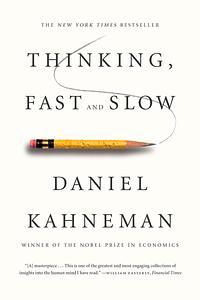You need to sign in or sign up before continuing.
Take a photo of a barcode or cover
challenging
informative
reflective
slow-paced
This is book is essentially the synthesis of Kahneman’s long and illustrious research career, and it reads like a series of amusingly-told academic articles that more or less build on each other. It gets 5 stars from me for the content, but 3 stars for the need to slog through it.
I loved Kahneman’s dry humor, the many examples to aid comprehension, and the insightful view into the limits of human rationality.
I did not like that so many examples made it so long. It suffers from the common problem of nonfiction books that perhaps should have been articles. If only it had been 30% shorter!
On the whole, I recommend it, but if you are already familiar with some behavioral economics, my recommendation is to feel free to skim it when you get bored, excepting the first few chapters and section 5. Those are gold.
Some concepts to note: priming, WYSIATI, narrow framing, the inside view, preference reversals, intensity matching and associative coherence, anchoring.
The practical guide along the same lines of this book appears to be Nudge, which is now firmly on my reading list (and I hope will be a more concise read).
I loved Kahneman’s dry humor, the many examples to aid comprehension, and the insightful view into the limits of human rationality.
I did not like that so many examples made it so long. It suffers from the common problem of nonfiction books that perhaps should have been articles. If only it had been 30% shorter!
On the whole, I recommend it, but if you are already familiar with some behavioral economics, my recommendation is to feel free to skim it when you get bored, excepting the first few chapters and section 5. Those are gold.
Some concepts to note: priming, WYSIATI, narrow framing, the inside view, preference reversals, intensity matching and associative coherence, anchoring.
The practical guide along the same lines of this book appears to be Nudge, which is now firmly on my reading list (and I hope will be a more concise read).
good book. Kahneman and Tversky are so influential that I was already exposed to most concepts in the book even before reading it. in that sense I didn't learn as much as I would've liked to - it is a pretty lengthy read
challenging
informative
reflective
slow-paced
informative
medium-paced
challenging
informative
inspiring
lighthearted
reflective
medium-paced
Mind-blowing. Gave me completely new ways of looking at the world
informative
slow-paced
What I loved about this book also frustrated me at times. Daniel Kahneman is a scholarly academic who studied and practiced and discusses human behavioral decision making thoroughly through his life. Him and Amos Tversky (among several other collaborators mentioned throughout the book) developed several theories, thought experiments, surveys, and more on the human’s ability to make decisions. Through the book, he communicates countless phrases and “heuristics” to explain specific phenomena in errors of judgement. It is with the intense knowledge and academic investigation that this book is well-written, but often drags points further than the average human may care to investigate. And because of these intense investigations, sometimes the larger point gets lost and is not effectively communicated.
There were several chapter periods through the middle of the book where I wondered “how does this tie back into the theme of the two systems you were eager to define in the early portion of the book?” This definitely provided some struggle for me as someone who came to this book hoping to understand how the different modes of thinking impact my daily life and decision making. But still, this book maintained credibility in my eyes and I persisted through some of the denser chapters.
In the end, he concludes quite succinctly, in my opinion. Wrapping up the three separate distinctions he made through the book and summarizing common human fallacies really helped me wrangle some thoughts about the book as a whole and my own life and decisions. I foresee myself recommending this book to friends and family with the hopes of discussing human nature. I also see myself revisiting the conclusion chapter whenever I feel I’m falling for these cognitive pitfalls in my own life.
There were several chapter periods through the middle of the book where I wondered “how does this tie back into the theme of the two systems you were eager to define in the early portion of the book?” This definitely provided some struggle for me as someone who came to this book hoping to understand how the different modes of thinking impact my daily life and decision making. But still, this book maintained credibility in my eyes and I persisted through some of the denser chapters.
In the end, he concludes quite succinctly, in my opinion. Wrapping up the three separate distinctions he made through the book and summarizing common human fallacies really helped me wrangle some thoughts about the book as a whole and my own life and decisions. I foresee myself recommending this book to friends and family with the hopes of discussing human nature. I also see myself revisiting the conclusion chapter whenever I feel I’m falling for these cognitive pitfalls in my own life.
challenging
informative
inspiring
medium-paced
Loved the concepts laid out in this book. Why we do the things we do. Why our mind convinces us to think about things in the wrong way. The statistics and strategies to really understand incentives and approaches to decision making
slow-paced

